DOI: https://doi.org/10.1029/2023gl107652
تاريخ النشر: 2024-02-21
مهمة سطح المياه وتضاريس المحيط: تقدم في استشعار الرادار عن بُعد لسطح المحيط والمياه السطحية للأرض
– للاستشهاد بهذه النسخة:
معرف HAL: hal-04631624
https://hal.science/hal-04631624v1
رسائل البحث الجيوفيزيائي
رسالة بحثية
10.1029/2023GL107652
قسم خاص:
النقاط الرئيسية:
- أول ملاحظات فضائية لسطح المحيط تحت المقياس الفرعي لفهم دور المحيط في امتصاص الحرارة من الغلاف الجوي
- أول ملاحظات فضائية لتغير تخزين المياه في البحيرات ومعدلات تدفق الأنهار لفهم دورة المياه العذبة
- أول ملاحظات فضائية لتفاصيل تغيير مستويات المياه الساحلية لتقييم تأثير ارتفاع مستوى سطح البحر المحلي
المراسلة إلى:
اقتباس:
تم القبول في 5 فبراير 2024
مساهمات المؤلفين:
© 2024 مختبر الدفع النفاث، معهد كاليفورنيا للتكنولوجيا والمؤلفون. تم الاعتراف برعاية الحكومة. تم المساهمة في هذه المقالة من قبل موظفي الحكومة الأمريكية وعملهم في الملكية العامة في الولايات المتحدة الأمريكية.
هذه مقالة مفتوحة الوصول بموجب شروط ترخيص المشاع الإبداعي النسب-غير التجاري-لا مشتقات، الذي يسمح بالاستخدام والتوزيع في أي وسيلة، بشرط أن يتم الاستشهاد بالعمل الأصلي بشكل صحيح، وأن يكون الاستخدام غير تجاري، وألا يتم إجراء أي تعديلات أو تكييفات.
بعثة سطح المياه وتضاريس المحيط: تقدم في استشعار الرادار عن بُعد للمحيط ومياه سطح الأرض
الملخص
تحتوي ارتفاعات أسطح المياه على معلومات مهمة حول محيطات الأرض ومياه السطح الأرضية. يرتبط ارتفاع سطح البحر في المحيطات بالتغير الداخلي في كثافة المحيط وكتلته المرتبطة بدوران المحيط واستجابته لتغير المناخ. تعتبر معدلات تدفق الأنهار وتغيرات حجم البحيرات حاسمة لإمدادات المياه العذبة والمخاطر الناتجة عن الفيضانات والجفاف الناتجة عن الأحداث المناخية المتطرفة. مهمة سطح المياه وتضاريس المحيطات (SWOT) هي قمر صناعي جديد يستخدم تقنية رادار متقدمة لتحقيق تقدم في مراقبة تباين ارتفاع أسطح المياه على مستوى العالم، مما يوفر معلومات جديدة تمامًا لم تكن متاحة سابقًا لدراسة مياه الأرض. هنا، نقدم النتائج الأولى لمهمة SWOT فوق المحيطات والأنهار والبحيرات. نحن نوضح إمكانيات المهمة للإجابة على الأسئلة العلمية في علم المحيطات والهيدرولوجيا.
الملخص
ملخص بلغة بسيطة الأرض كوكب مائي. الكمية الهائلة من مياه المحيطات قد خزنت معظم الحرارة التي أُطلقت إلى الغلاف الجوي منذ الثورة الصناعية من خلال حرق الوقود الأحفوري. وبالتالي، يتم تعديل تغير المناخ بواسطة المحيط. على اليابسة، تتأثر المياه العذبة في البحيرات والأنهار والخزانات، وهي مورد طبيعي حيوي، بالمناخ المتزايد الحرارة والتعديلات البشرية المباشرة. تحدث عمليات امتصاص المحيط للحرارة والكربون من الغلاف الجوي ودورة المياه العذبة على اليابسة على مقاييس مكانية صغيرة جداً لم يتم قياسها بشكل كافٍ من الفضاء. تم إطلاق قمر صناعي جديد، وهو مهمة سطح المياه وتضاريس المحيط (SWOT)، في ديسمبر 2022. باستخدام تكنولوجيا الرادار المتقدمة، يوفر SWOT ملاحظات عالمية غير مسبوقة لفهم دور المحيط في تغير المناخ وكيف تستجيب موارد المياه العذبة للتأثير البشري. ستعزز ملاحظات SWOT بالقرب من السواحل أيضاً فهم كيفية تأثير ارتفاع مستويات البحر على تلك السواحل.
1. المقدمة
المنهجية: جيرالد ديباربوري التحقق: تاملين بافلسكي، جان-فرانسوا كريتو، روزماري مورو، ج. توماس فارار، باراج فاز، بيير سينجينس، ناديا فينوجرادوفا-شيفر، أنيك سيلفستر-بارون، نيكولا بيكو الكتابة – المسودة الأصلية:
تاملين بافيلسكي، جان-فرانسوا كريتو، روزماري مورو، ج. توماس فارار، باراج فاز، بيير سينجينس، ناديا فينوجرادوفا-شيفر، أنيك سيلفستر-بارون، نيكولا بيكو
2. العمليات المحيطية الصغيرة النطاق
2.1. التحليل الطيفي
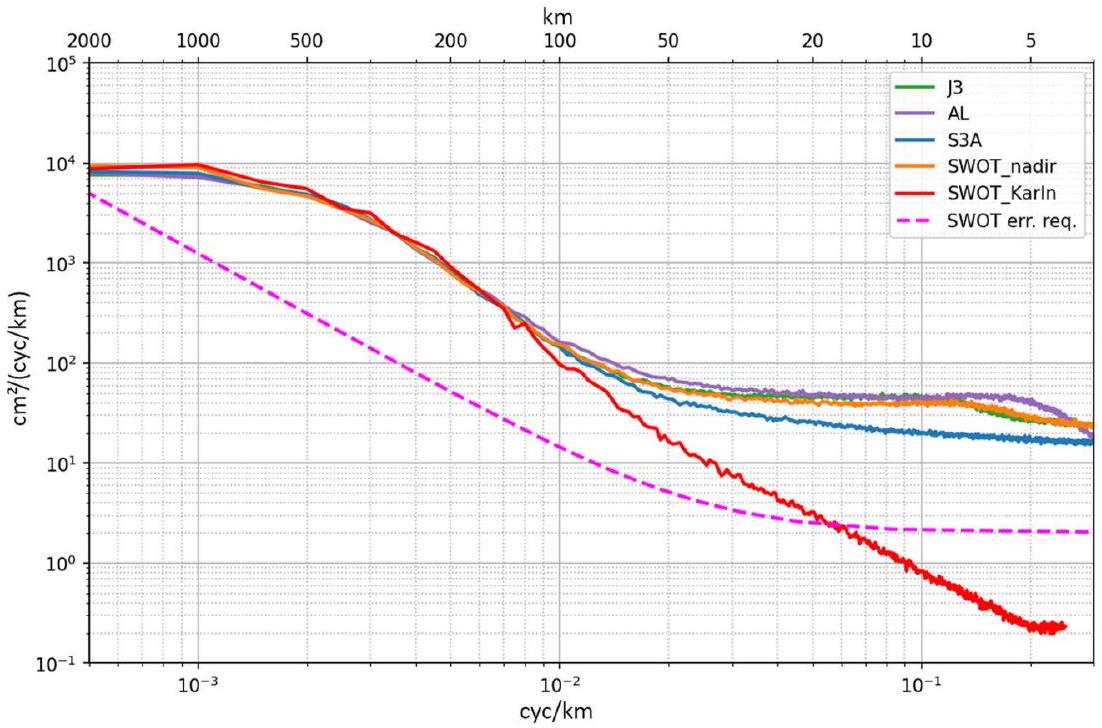
2.2. الدوامات والجبهات الصغيرة النطاق في المحيط
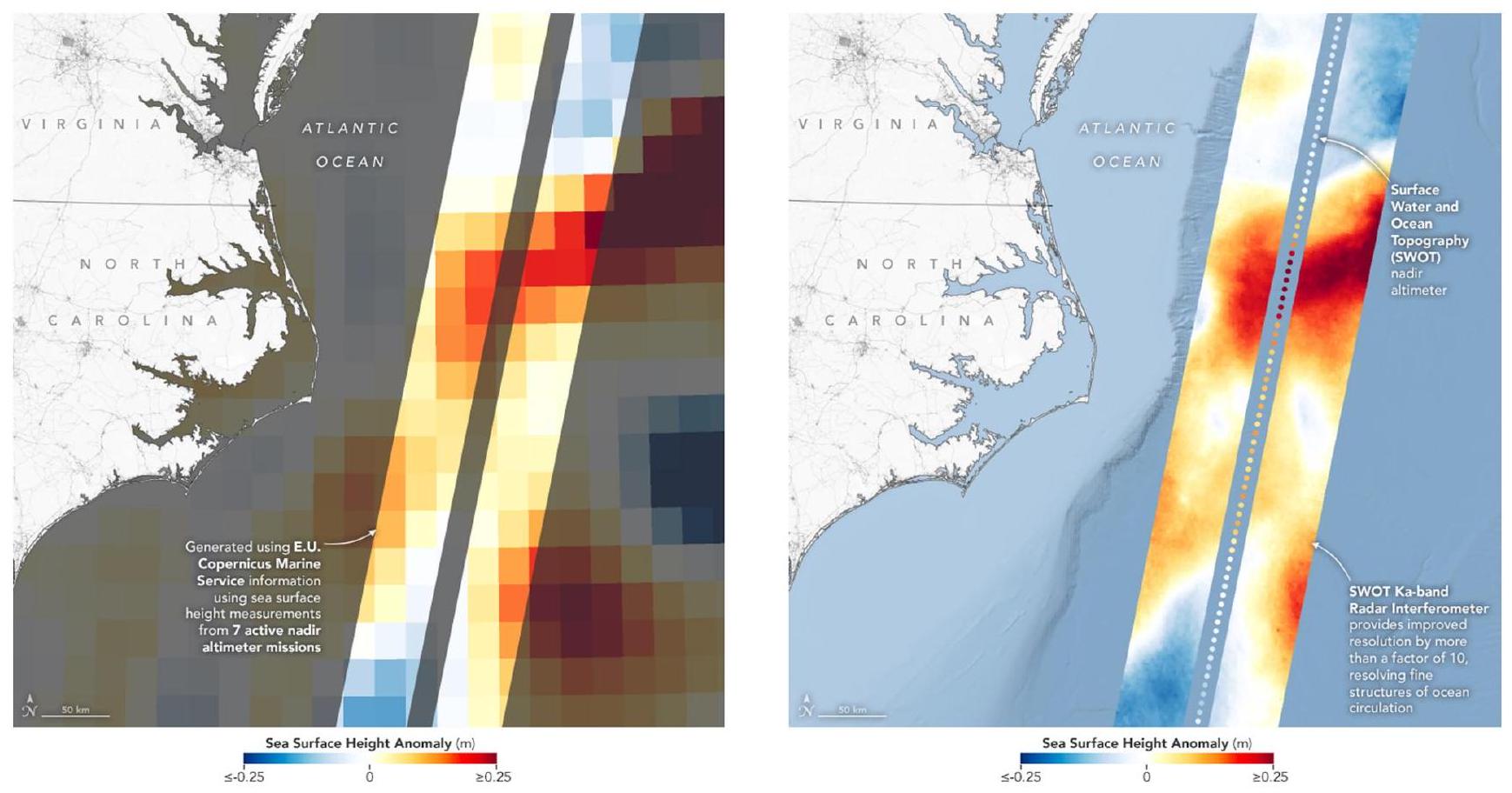
2.3. الأمواج الداخلية المنفردة
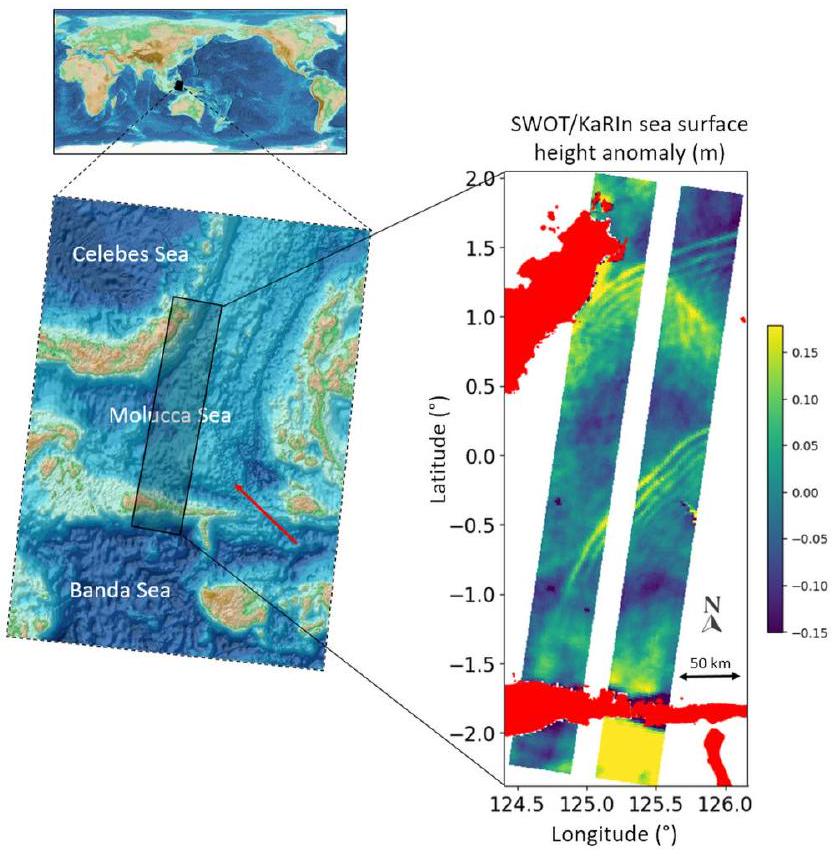
3. ملاحظات الأنهار والبحيرات
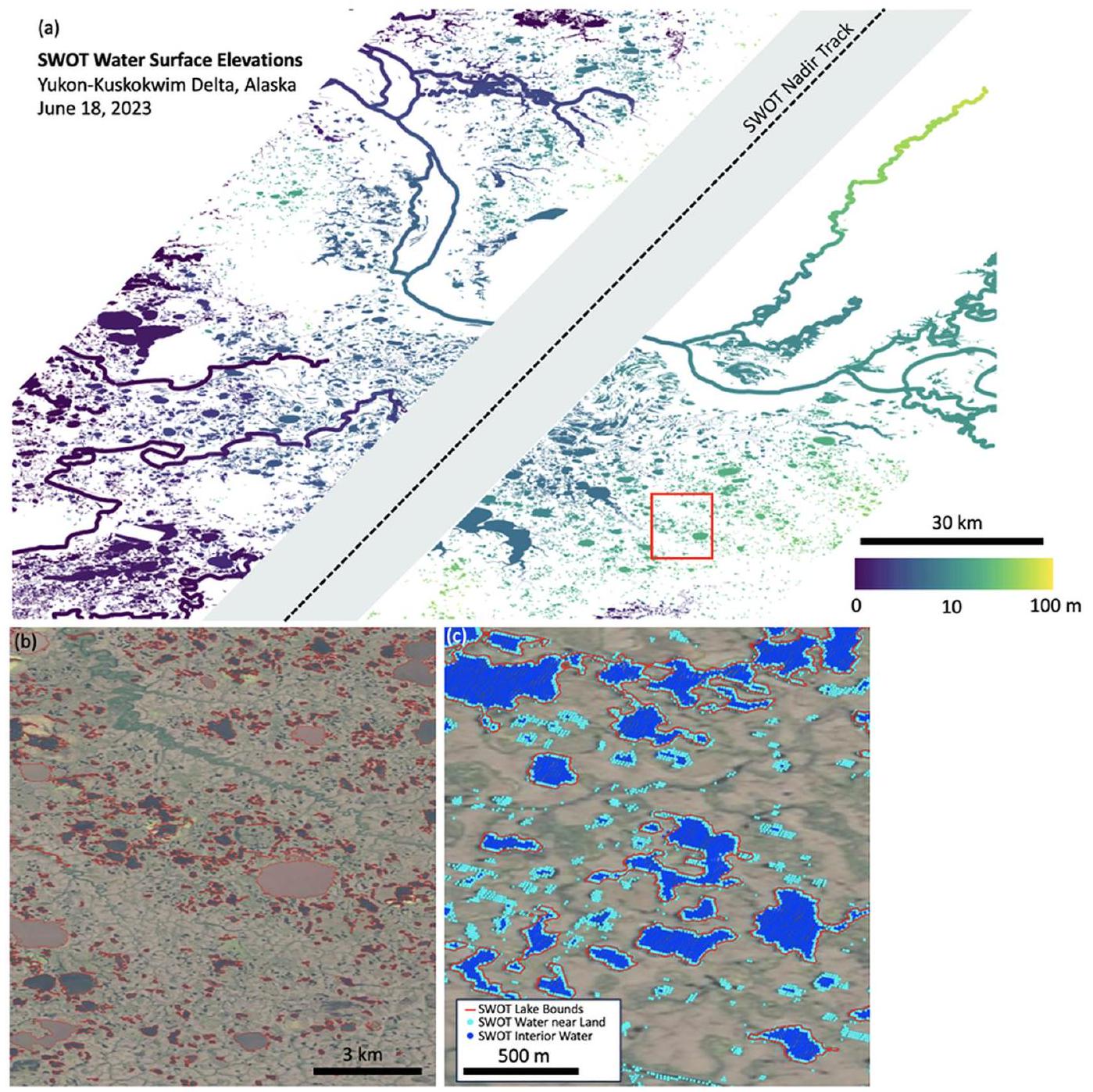
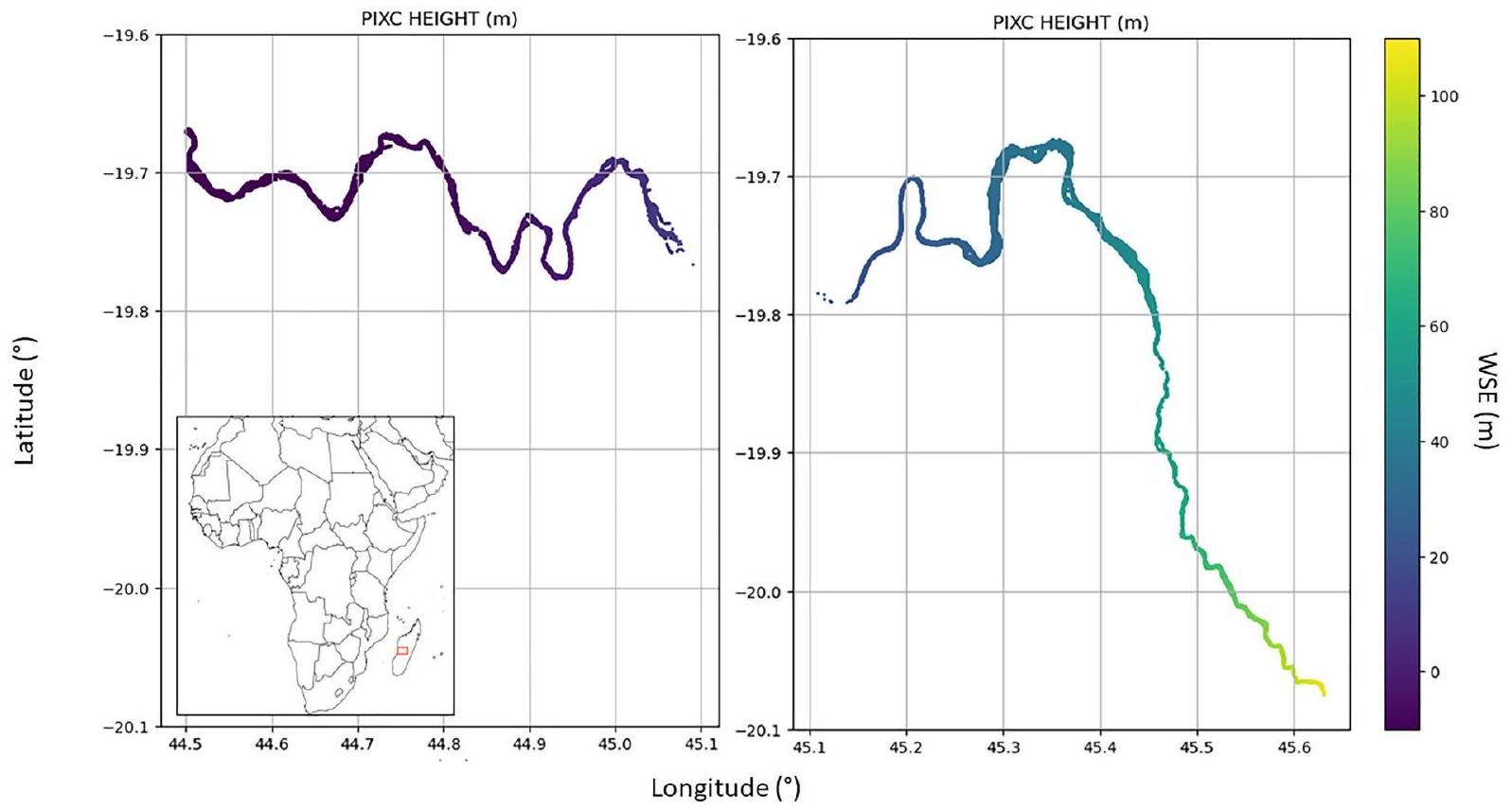
4. الاستنتاجات
بيان توفر البيانات
- تُوزع منتجات SWOT المستخدمة في المخطوطة من قبل مراكز المرآة التابعة لناسا وCNES. يمكن تنزيل منتجات SWOT من أي من المستودعين. تحتوي كل منتج من منتجات SWOT على وثيقة وصف منتج محددة (PDD) ومعرف كائن رقمي (DOI).
CNES (2023b) هو مستودع AVISO لمنتجات المحيطات
CNES (2023a) هو مستودع HYDROWEB لمنتجات الهيدرولوجيا.
- من بين مجموعة متنوعة من منتجات تحليل SWOT المتاحة في المستودعات، يستخدم هذا البحث أربعة منتجات على وجه التحديد:
رسائل البحث الجيوفيزيائي
شكر وتقدير
منتج بيانات ارتفاع سطح البحر منخفض المعدل من SWOT Level 2 KaRIn، الإصدار 1.1 متاح في مشروع SWOT (2023b).
منتج بيانات مستوى 2 من SWOT KaRIn لمعدل البحيرات العالية، الإصدار 1.1 (PODAAC، معرف المجموعة: SWOT_L2_HR_LakeSP_1.1) متاح في مشروع SWOT (2023f).
منتج بيانات مقياس الارتفاع نادير من المستوى الثاني SWOT (AVISO، المجموعة: L2_NALT_IGDR) متاح في مشروع SWOT (2023c).
- تستخدم هذه الورقة أيضًا منتجات المستوى الثالث من مهام القياس عن بعد الأخرى (وهي Sentinel-3 وJason-3 وSARAL) في الشكل 1، بالإضافة إلى منتجات المستوى الرابع المصفوفة من أقمار القياس عن بعد الأخرى في الشكل 2. هذه البيانات متاحة في مستودع خدمة كوبرنيكوس البحرية (2023).
- المنتج الشبكي من المستوى 4 هو في مشروع SWOT (2023e).
- تم إنتاج منتجات SWOT من المستوى 1 والمستوى 2 بواسطة أقسام الأرض التابعة لقمر SWOT الصناعي من ناسا (إعادة معالجة غير متصلة بالإنترنت) وCNES (معالجة شبه حقيقية الوقت)، باستخدام خوارزميات ومعالجات موثقة في مستودع PODAAC. وثائق الأساس النظري للخوارزمية (ATBD) التي تصف هذه الخوارزميات والمعالجات متاحة ومفتوحة في PODAAC (2023). يتم تشغيل قسم الأرض التابع لناسا على خدمات أمازون ويب (AWS). يتم تشغيل قسم الأرض التابع لـ CNES على مركز بيانات خاص باستخدام نفس البرمجيات. تم إنتاج الأشكال من هذه المخطوطة باستخدام مزيج من مكتبات البرمجيات مفتوحة المصدر وحزم من مشروع PANGEO (مثل jupyter وdask وxarray وmatplotlib).
- الصور البصرية في الشكلين 4 ب و 4 ج هي صور خلفية موحدة من جوجل وهي مزيج من بيانات لاندسات وسينتينل 2 وماكسار.
References
Altenau, E. H., Pavelsky, T. M., Durand, M. T., Yang, X., Frasson, R. P. D. M., & Bendezu, L. (2021). The surface water and Ocean Topography (SWOT) mission River Database (SWORD): A global river network for satellite data products. Water Resources Research, 57(7), e2021WR030054. https://doi.org/10.1029/2021wr030054
Andriambeloson, J. A., Paris, A., Calmant, S., & Rakotondraompiana, S. (2020). Re-Initiating depth-discharge monitoring in small sized ungauged watersheds by combining remote sensing and hydrological modelling: A case study in Madagascar. Hydrological Sciences Journal, 65(16), 2709-2728. https://doi.org/10.1080/02626667.2020.1833013
Ballarotta, M., Ubelmann, C., Pujol, M. I., Taburet, G., Fournier, F., Legeais, J. F., et al. (2019). On the resolutions of ocean altimetry maps. Ocean Science, 15(4), 1091-1109. https://doi.org/10.5194/os-15-1091-2019
Biancamaria, S., Lettenmaier, D. P., & Pavelsky, T. M. (2016). The SWOT mission and its capabilities for land hydrology. Surveys in Geophysics, 37(2), 307-337. https://doi.org/10.1007/s10712-015-9346-y
Birkett, C. M. (1998). Contribution of the TOPEX NASA radar altimeter to the global monitoring of large rivers and wetlands. Water Resources Research, 34(5), 1223-1239. https://doi.org/10.1029/98WR00124
Castro, S. L., Emery, W. J., Wick, G. A., & Tandy, W. (2017). Submesoscale Sea surface temperature variability from UAV and satellite measurements. Remote Sensing, 9(11), 1089. https://doi.org/10.3390/rs9111089
CNES. (2023a). HYDROWEB repository for hydrology products [Dataset]. Hydroweb. Retrieved from https://hydroweb.next.theia-land.fr
CNES. (2023b). AVISO repository for ocean products. https://doi.org/10.24400/527896/a01-2023.016
Cooley, S. W., Ryan, J. C., & Smith, L. (2021). Human alteration of global surface water storage variability. Nature, 591(7848), 78-81. https://doi. org/10.1038/s41586-021-03262-3
Copernicus Marine Service repository. (2023). Level-4 gridded products of nadir altimetry satellites [Dataset]. CMEMS. Retrieved from https:// marine.copernicus.eu/access-data
Crétaux, J.-F., Abarca Del Río, R., Bergé-Nguyen, M., Arsen, A., Drolon, V., Clos, G., & Maisongrande, P. (2016). Lake volume monitoring from Space. Survey in geophysics, 37(2), 269-305. https://doi.org/10.1007/s10712-016-9362-6
Crétaux, J.-F., & Birkett, C. (2006). Lake studies from satellite altimetry. C R Geoscience, 338(14-15), 1098-1112. https://doi.org/10.1016/J.cre. 2006.08.002
Emery, C., Paris, A., Santos da Silva, J., Biancamaria, S., Boone, A., Calmant, S., & Garambois, P.-A. (2018). Large scale hydrological model river storage and discharge correction using satellite altimetry-based discharge product. HESS, 22(4), 2135-2162. https://doi.org/10.5194/hess-22-2135-2018
Farr, T., Rosen, P. A., Caro, E., Crippen, R., Duren, R., Hensley, S., et al. (2007). The Shuttle radar topography mission. Review of Geophysics, 45(2), RG2004. https://doi.org/10.1029/2005RG000183
Fu, L.-L., & Holt, B. (1984). Internal waves in the Gulf of California: Observations from a spaceborne radar. Journal of Geophysical Research, 89(C2), 2053-2060. https://doi.org/10.1029/jc089ic02p02053
Fu, L.-L., & Rodriguez, R. (2004). High-resolution measurement of ocean surface topography by radar interferometry for oceanographic and geophysical applications. In R. S. J. Sparks & C. J. Hawkesworth (Eds.), AGU geophysical monograph 150, IUGG Volume 19: State of the Planet: Frontiers and challenges (pp. 209-224).
Jackson, C. R. (2007). Internal wave detection using the moderate resolution imaging spectroradiometer (MODIS). Journal of Geophysical Research, 112(C11), C11012. https://doi.org/10.1029/2007JC004220
JPL-D61923. (2018). Surface water and Ocean Topography mission (SWOT) project science requirement document. In Document custodianShailen Desai. JPL document D-61923 (p. 29).
Koblinsky, C. J., Clarke, R. T., Brenner, A. C., & Frey, H. (1993). Measurement of river level variations with satellite altimetry. Water Resources Research, 29(6), 1839-1848. https://doi.org/10.1029/93WR00542
Lapeyre, G., & Klein, P. (2006). Impact of the small-scale elongated filaments on the oceanic vertical pump. Journal of Marine Research, 64(6), 835-851. https://doi.org/10.1357/002224006779698369
Le Gac, S., Boy, F., Blumstein, D., Lasson, L., & Picot, N. (2021). Benefits of the Open-Loop Tracking Command (OLTC): Extending conventional nadir altimetry to inland waters monitoring. Advances in Space Research, 68(2), 843-852. https://doi.org/10.1016/j.asr.2019.10.031
Magalhães, J. M., Alpers, W., Santos-Ferreira, A. M., & da Silva, J. C. B. (2021). Surface wave breaking caused by internal solitary waves: Effects on radar backscattering measured by SAR and radar altimeter. Oceanography, 34(2), 166-176. https://doi.org/10.5670/oceanog.2021.203
Massonnet, D., Rossi, M., Carmona, C., Adragna, F., Peltzer, G., Feigl, K., & Rabaute, T. (1993). The displacement field of the Landers earthquake mapped by radar interferometry. Nature, 364(6433), 138-142. https://doi.org/10.1038/364138a0
Morrow, R., Fu, L.-L., Ardhuin, F., Benkiran, M., Chapron, B., Cosme, E., et al. (2019). Global observations of fine-scale ocean surface topography with the surface water and Ocean Topography (SWOT) mission. Frontiers in Marine Science, 6, 232. https://doi.org/10.3389/ fmars.2019.00232
NASA. (2023). PODAAC repository for both ocean and hydrology products [Dataset]. NASA. Retrieved from https://podaac.jpl.nasa.gov/swot? tab=datasets
Papa, F., & Frappart, F. (2021). Surface water storage in rivers and wetlands derived from satellite observations: A review of current advances and future opportunities for hydrological sciences. Remote Sensing, 13(20), 4162. https://doi.org/10.3390/rs13204162
PODAAC. (2023). SWOT algorithm theoretical Basis document. Retrieved from https://podaac.jpl.nasa.gov/swot?tab=datasetsinformation§ions=about%2Bdata
Rodriguez, E., Esteban-Fernandez, D., Peral, E., Chen, C., De Bleser, J.-W., & Williams, B. (2017). Wide-swath altimetry: A review. In D. Stammer & A. Cazenave (Eds.), Satellite altimetry over oceans and land surfaces (pp. 71-112). https://doi.org/10.1201/9781315151779-2
SWOT Project. (2023a). Level 2 KaRIn high Rate River Single pass data product, version 1.1 [Dataset]. (PODAAC, collection ID: SWOT_L2_HR_RiverSP_1.1). https://doi.org/10.5067/SWOT-RIVERSP-1.1
SWOT Project. (2023b). Level 2 KaRIn low rate Sea Surface height data product, version 1.1 [Dataset]. (AVISO, beta prevalidated collection) or (PODAAC, collection ID: SWOT_L2_LR_SSH_1.1). https://doi.org/10.24400/527896/a01-2023.015
SWOT Project. (2023c). Level-2 nadir altimeter data product [Dataset]. (AVISO, collection: L2_NALT_IGDR). https://doi.org/10.24400/ 527896/a01-2023.005
SWOT Project. (2023d). Level-3 along-track product SEALEVEL_GLO_PHY_L3_MY_008_062 [Dataset]. Earth System Science Data. https:// doi.org/10.48670/moi-00146
SWOT Project. (2023e). Level-4 gridded product SEALEVEL_GLO_PHY_L4_MY_008_047 [Dataset]. Copernicus Marine Data Store. https:// doi.org/10.48670/moi-00148
SWOT Project. (2023f). SWOT level-2 KaRIn high Rate Lake Single pass data product, version 1.1 [Dataset]. (PODAAC, collection ID: SWOT_L2_HR_LakeSP_1.1). https://doi.org/10.48670/moi-0014810.5067/SWOT-LAKESP-1.1
Tarpanelli, A., Paris, A., Sichangi, A. W., O’ Loughlin, F., & Papa, F. (2022). Water resources in Africa: The role of earth observation data and hydrodynamic modeling for derive river discharge. Survey in geophysics, 44(1), 97-122. https://doi.org/10.1007/s10712-022-09744-x
Vergara, O., Morrow, R., Pujol, I., Dibarboure, G., & Ubelmann, C. (2019). Revised global wave number spectra from recent altimeter observations. Journal of Geophysical Research: Oceans, 124(6), 3523-3537. https://doi.org/10.1029/2018jc014844
DOI: https://doi.org/10.1029/2023gl107652
Publication Date: 2024-02-21
The Surface Water and Ocean Topography Mission: A Breakthrough in Radar Remote Sensing of the Ocean and Land Surface Water
– To cite this version:
HAL Id: hal-04631624
https://hal.science/hal-04631624v1
Geophysical Research Letters’
RESEARCH LETTER
10.1029/2023GL107652
Special Section:
Key Points:
- The first space observations of submesoscale ocean surface topography for understanding ocean’s role in heat uptake from the atmosphere
- The first space observations of the change of water storage of lakes and flow rates of rivers for understanding the freshwater cycle
- The first space observations of the details of the change of coastal water levels to assess the impact of local sea level rise
Correspondence to:
Citation:
Accepted 5 FEB 2024
Author Contributions:
© 2024 Jet Propulsion Laboratory, California Institute of Technology and The Authors. Government sponsorship acknowledged. This article has been contributed to by U.S. Government employees and their work is in the public domain in the USA.
This is an open access article under the terms of the Creative Commons Attribution-NonCommercial-NoDerivs License, which permits use and distribution in any medium, provided the original work is properly cited, the use is non-commercial and no modifications or adaptations are made.
The Surface Water and Ocean Topography Mission: A Breakthrough in Radar Remote Sensing of the Ocean and Land Surface Water
Abstract
The elevations of water surfaces hold important information on the earth’s oceans and land surface waters. Ocean sea surface height is related to the internal change of the ocean’s density and mass associated with ocean circulation and its response to climate change. The flow rates of rivers and volume changes of lakes are crucial to freshwater supplies and the hazards of floods and drought resulting from extreme weather and climate events. The Surface Water and Ocean Topography (SWOT) Mission is a new satellite using advanced radar technology to make headway in observing the variability of the elevation of water surfaces globally, providing fundamentally new information previously not available to the study of earth’s waters. Here, we provide the first results of SWOT over oceans, rivers, and lakes. We demonstrate the potential of the mission to address science questions in oceanography and hydrology.
Abstract
Plain Language Summary Earth is a water planet. The vast amount of ocean water has stored most of the heat released to the atmosphere since the Industrial Revolution through burning fossil fuels. Climate change is thus moderated by the ocean. Over land the freshwater in lakes, rivers, and reservoirs, a critical natural resource, is affected by the warming climate and direct human modifications. Processes of oceanic uptake of heat and carbon from the atmosphere and cycling of freshwater on land take place at spatial scales too small to have been adequately quantified from space. A new satellite, the Surface Water and Ocean Topography (SWOT) mission, was launched in December 2022. Using advanced radar technology, SWOT provides unprecedented global observations for understanding the ocean’s role in climate change and how freshwater resources respond to human influence. SWOT observations near coasts will also advance understanding of how rising sea levels impact those coasts.
1. Introduction
Methodology: Gerald Dibarboure Validation: Tamlin Pavelsky, JeanFrancois Cretaux, Rosemary Morrow, J. Thomas Farrar, Parag Vaze, Pierre Sengenes, Nadya VinogradovaShiffer, Annick Sylvestre-Baron, Nicolas Picot Writing – original draft:
Tamlin Pavelsky, Jean-Francois Cretaux, Rosemary Morrow, J. Thomas Farrar, Parag Vaze, Pierre Sengenes, Nadya Vinogradova-Shiffer, Annick Sylvestre-Baron, Nicolas Picot
2. Small-Scale Oceanic Processes
2.1. Spectral Analysis

2.2. Small-Scale Ocean Eddies and Fronts

2.3. Internal Solitary Waves

3. Observations of Rivers and Lakes


4. Conclusions
Data Availability Statement
- The SWOT products used in the manuscript are distributed by mirror centers from NASA and CNES. The SWOT products can be downloaded from either repository. Each SWOT product has a specific product description document (PDD) and digital object identifier (DOI).
CNES (2023b) is the AVISO repository for ocean products
CNES (2023a) is the HYDROWEB repository for hydrology products.
- Among the variety of SWOT products available on the repositories, this paper specifically uses four products:
Geophysical Research Letters
Acknowledgments
The SWOT Level 2 KaRIn Low Rate Sea Surface Height Data Product, Version 1.1 is available in SWOT Project (2023b).
The SWOT Level-2 KaRIn High Rate Lake Single Pass Data Product, Version 1.1 (PODAAC, collection ID:SWOT_L2_HR_LakeSP_1.1) is available in SWOT Project (2023f).
The SWOT Level-2 Nadir Altimeter Data Product (AVISO, collection: L2_NALT_IGDR) is available in SWOT Project (2023c).
- This paper also uses Level-3 products from other altimetry missions (namely Sentinel-3, Jason-3, SARAL) in Figure 1, as well as Level-4 gridded products other nadir altimetry satellites in Figure 2. These datasets are available in Copernicus Marine Service repository (2023).
- The Level-4 gridded product is in SWOT Project (2023e).
- The SWOT Level-1 and Level-2 products were generated by the SWOT satellite ground segments from NASA (offline reprocessing) and CNES (near-real time processing), using algorithms and processors documented on the PODAAC repository. The Algorithm Theoretical Basis Documents (ATBD) describing said algorithms and processors is open and available in PODAAC (2023). The NASA ground segment is operated on the Amazon Web Services (AWS). The CNES ground segment is operated on a proprietary datacenter using the same software. The figures from this manuscript were produced with a combination of open source software libraries and packages from the PANGEO project (e.g., jupyter, dask, xarray, matplotlib).
- The optical imagery in Figures 4 b and 4 c is standardized background imagery from Google and is an amalgam of Landsat, Sentinel 2, and Maxar data.
References
Altenau, E. H., Pavelsky, T. M., Durand, M. T., Yang, X., Frasson, R. P. D. M., & Bendezu, L. (2021). The surface water and Ocean Topography (SWOT) mission River Database (SWORD): A global river network for satellite data products. Water Resources Research, 57(7), e2021WR030054. https://doi.org/10.1029/2021wr030054
Andriambeloson, J. A., Paris, A., Calmant, S., & Rakotondraompiana, S. (2020). Re-Initiating depth-discharge monitoring in small sized ungauged watersheds by combining remote sensing and hydrological modelling: A case study in Madagascar. Hydrological Sciences Journal, 65(16), 2709-2728. https://doi.org/10.1080/02626667.2020.1833013
Ballarotta, M., Ubelmann, C., Pujol, M. I., Taburet, G., Fournier, F., Legeais, J. F., et al. (2019). On the resolutions of ocean altimetry maps. Ocean Science, 15(4), 1091-1109. https://doi.org/10.5194/os-15-1091-2019
Biancamaria, S., Lettenmaier, D. P., & Pavelsky, T. M. (2016). The SWOT mission and its capabilities for land hydrology. Surveys in Geophysics, 37(2), 307-337. https://doi.org/10.1007/s10712-015-9346-y
Birkett, C. M. (1998). Contribution of the TOPEX NASA radar altimeter to the global monitoring of large rivers and wetlands. Water Resources Research, 34(5), 1223-1239. https://doi.org/10.1029/98WR00124
Castro, S. L., Emery, W. J., Wick, G. A., & Tandy, W. (2017). Submesoscale Sea surface temperature variability from UAV and satellite measurements. Remote Sensing, 9(11), 1089. https://doi.org/10.3390/rs9111089
CNES. (2023a). HYDROWEB repository for hydrology products [Dataset]. Hydroweb. Retrieved from https://hydroweb.next.theia-land.fr
CNES. (2023b). AVISO repository for ocean products. https://doi.org/10.24400/527896/a01-2023.016
Cooley, S. W., Ryan, J. C., & Smith, L. (2021). Human alteration of global surface water storage variability. Nature, 591(7848), 78-81. https://doi. org/10.1038/s41586-021-03262-3
Copernicus Marine Service repository. (2023). Level-4 gridded products of nadir altimetry satellites [Dataset]. CMEMS. Retrieved from https:// marine.copernicus.eu/access-data
Crétaux, J.-F., Abarca Del Río, R., Bergé-Nguyen, M., Arsen, A., Drolon, V., Clos, G., & Maisongrande, P. (2016). Lake volume monitoring from Space. Survey in geophysics, 37(2), 269-305. https://doi.org/10.1007/s10712-016-9362-6
Crétaux, J.-F., & Birkett, C. (2006). Lake studies from satellite altimetry. C R Geoscience, 338(14-15), 1098-1112. https://doi.org/10.1016/J.cre. 2006.08.002
Emery, C., Paris, A., Santos da Silva, J., Biancamaria, S., Boone, A., Calmant, S., & Garambois, P.-A. (2018). Large scale hydrological model river storage and discharge correction using satellite altimetry-based discharge product. HESS, 22(4), 2135-2162. https://doi.org/10.5194/hess-22-2135-2018
Farr, T., Rosen, P. A., Caro, E., Crippen, R., Duren, R., Hensley, S., et al. (2007). The Shuttle radar topography mission. Review of Geophysics, 45(2), RG2004. https://doi.org/10.1029/2005RG000183
Fu, L.-L., & Holt, B. (1984). Internal waves in the Gulf of California: Observations from a spaceborne radar. Journal of Geophysical Research, 89(C2), 2053-2060. https://doi.org/10.1029/jc089ic02p02053
Fu, L.-L., & Rodriguez, R. (2004). High-resolution measurement of ocean surface topography by radar interferometry for oceanographic and geophysical applications. In R. S. J. Sparks & C. J. Hawkesworth (Eds.), AGU geophysical monograph 150, IUGG Volume 19: State of the Planet: Frontiers and challenges (pp. 209-224).
Jackson, C. R. (2007). Internal wave detection using the moderate resolution imaging spectroradiometer (MODIS). Journal of Geophysical Research, 112(C11), C11012. https://doi.org/10.1029/2007JC004220
JPL-D61923. (2018). Surface water and Ocean Topography mission (SWOT) project science requirement document. In Document custodianShailen Desai. JPL document D-61923 (p. 29).
Koblinsky, C. J., Clarke, R. T., Brenner, A. C., & Frey, H. (1993). Measurement of river level variations with satellite altimetry. Water Resources Research, 29(6), 1839-1848. https://doi.org/10.1029/93WR00542
Lapeyre, G., & Klein, P. (2006). Impact of the small-scale elongated filaments on the oceanic vertical pump. Journal of Marine Research, 64(6), 835-851. https://doi.org/10.1357/002224006779698369
Le Gac, S., Boy, F., Blumstein, D., Lasson, L., & Picot, N. (2021). Benefits of the Open-Loop Tracking Command (OLTC): Extending conventional nadir altimetry to inland waters monitoring. Advances in Space Research, 68(2), 843-852. https://doi.org/10.1016/j.asr.2019.10.031
Magalhães, J. M., Alpers, W., Santos-Ferreira, A. M., & da Silva, J. C. B. (2021). Surface wave breaking caused by internal solitary waves: Effects on radar backscattering measured by SAR and radar altimeter. Oceanography, 34(2), 166-176. https://doi.org/10.5670/oceanog.2021.203
Massonnet, D., Rossi, M., Carmona, C., Adragna, F., Peltzer, G., Feigl, K., & Rabaute, T. (1993). The displacement field of the Landers earthquake mapped by radar interferometry. Nature, 364(6433), 138-142. https://doi.org/10.1038/364138a0
Morrow, R., Fu, L.-L., Ardhuin, F., Benkiran, M., Chapron, B., Cosme, E., et al. (2019). Global observations of fine-scale ocean surface topography with the surface water and Ocean Topography (SWOT) mission. Frontiers in Marine Science, 6, 232. https://doi.org/10.3389/ fmars.2019.00232
NASA. (2023). PODAAC repository for both ocean and hydrology products [Dataset]. NASA. Retrieved from https://podaac.jpl.nasa.gov/swot? tab=datasets
Papa, F., & Frappart, F. (2021). Surface water storage in rivers and wetlands derived from satellite observations: A review of current advances and future opportunities for hydrological sciences. Remote Sensing, 13(20), 4162. https://doi.org/10.3390/rs13204162
PODAAC. (2023). SWOT algorithm theoretical Basis document. Retrieved from https://podaac.jpl.nasa.gov/swot?tab=datasetsinformation§ions=about%2Bdata
Rodriguez, E., Esteban-Fernandez, D., Peral, E., Chen, C., De Bleser, J.-W., & Williams, B. (2017). Wide-swath altimetry: A review. In D. Stammer & A. Cazenave (Eds.), Satellite altimetry over oceans and land surfaces (pp. 71-112). https://doi.org/10.1201/9781315151779-2
SWOT Project. (2023a). Level 2 KaRIn high Rate River Single pass data product, version 1.1 [Dataset]. (PODAAC, collection ID: SWOT_L2_HR_RiverSP_1.1). https://doi.org/10.5067/SWOT-RIVERSP-1.1
SWOT Project. (2023b). Level 2 KaRIn low rate Sea Surface height data product, version 1.1 [Dataset]. (AVISO, beta prevalidated collection) or (PODAAC, collection ID: SWOT_L2_LR_SSH_1.1). https://doi.org/10.24400/527896/a01-2023.015
SWOT Project. (2023c). Level-2 nadir altimeter data product [Dataset]. (AVISO, collection: L2_NALT_IGDR). https://doi.org/10.24400/ 527896/a01-2023.005
SWOT Project. (2023d). Level-3 along-track product SEALEVEL_GLO_PHY_L3_MY_008_062 [Dataset]. Earth System Science Data. https:// doi.org/10.48670/moi-00146
SWOT Project. (2023e). Level-4 gridded product SEALEVEL_GLO_PHY_L4_MY_008_047 [Dataset]. Copernicus Marine Data Store. https:// doi.org/10.48670/moi-00148
SWOT Project. (2023f). SWOT level-2 KaRIn high Rate Lake Single pass data product, version 1.1 [Dataset]. (PODAAC, collection ID: SWOT_L2_HR_LakeSP_1.1). https://doi.org/10.48670/moi-0014810.5067/SWOT-LAKESP-1.1
Tarpanelli, A., Paris, A., Sichangi, A. W., O’ Loughlin, F., & Papa, F. (2022). Water resources in Africa: The role of earth observation data and hydrodynamic modeling for derive river discharge. Survey in geophysics, 44(1), 97-122. https://doi.org/10.1007/s10712-022-09744-x
Vergara, O., Morrow, R., Pujol, I., Dibarboure, G., & Ubelmann, C. (2019). Revised global wave number spectra from recent altimeter observations. Journal of Geophysical Research: Oceans, 124(6), 3523-3537. https://doi.org/10.1029/2018jc014844
